- By Dan Veaner
- Around Town
 Print
Print 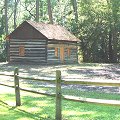 If you think building a house is hard, try rebuilding one with no money, tools, or materials! That was the challenge the Town of Lansing faced when former Councilman Bud Shattuck started his campaign to save Lansing's (an Tompkins and Cayuga Counties) oldest log cabin. The first phase was rescuing it from the Cayuga Museum in Auburn, which had no further use for it. That was Shattuck's piece. Next Ed LaVigne and the Lansing Community Council raised the money to get the cabin reassembled in Myers Park. The last piece is the chinking (the mudding that insulates between the logs), the doors, and the windows. Enter Carl Coté and Results Renovation and Repair, who are donating their time and skills to the project. Last weekend the chinking on the cabin exterior was completed.
If you think building a house is hard, try rebuilding one with no money, tools, or materials! That was the challenge the Town of Lansing faced when former Councilman Bud Shattuck started his campaign to save Lansing's (an Tompkins and Cayuga Counties) oldest log cabin. The first phase was rescuing it from the Cayuga Museum in Auburn, which had no further use for it. That was Shattuck's piece. Next Ed LaVigne and the Lansing Community Council raised the money to get the cabin reassembled in Myers Park. The last piece is the chinking (the mudding that insulates between the logs), the doors, and the windows. Enter Carl Coté and Results Renovation and Repair, who are donating their time and skills to the project. Last weekend the chinking on the cabin exterior was completed."Our objective is to get the outside of the cabin all chinked before the Lansing Harbor Festival on August 14th," Coté says. "We'll have a door that allows the inside to be accessible. By this Fall we'll definitely have both doors and the windows completed. The inside chinking may occur late this Fall. We'd be able to keep some heat in there if need be, so we can do it in cooler temperatures."
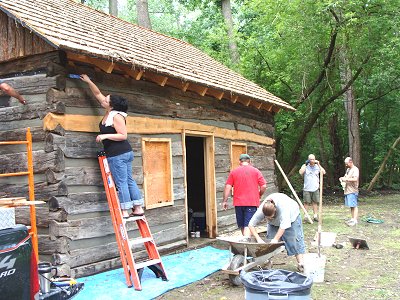
LaVigne recruited Coté for the project and has let him run with it. While LaVigne and the council focused on the Myers Park Playground Project (MP3) and gear up for Harbor Festival, Coté, his brother Jaques, partner Mike Cody, and friends Bill and Jeff Mondics have been quietly working on the cabin at the entrance to the park. The Cotés and Cody make up the Groton based Results Renovation and Repair, and the Mondics are Ithaca union laborers who often work with the firm. All have volunteered their time to the project. On Saturday Coté's neice Andrea and her grandfather and Bill Mondic's daughter Jocelyn joined the crew to apply the chinking.
"They're always eager and willing to lend a hand when they need to, and thought this would be a project they would like to be involved in," Coté says. "It's nice to give back to the community. We make our livings off of the surrounding communities. It's nice to give back once in a while. This is our way of thanking them."
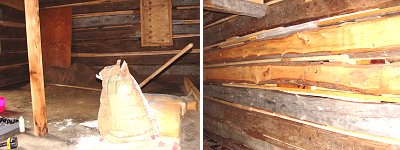 A ton of sand, about 600 pounds of Portland cement mix, and 100 pounds of lime were donated for the chinking (left). 2x4s were also donated to fill the gaps between the logs (right). A ton of sand, about 600 pounds of Portland cement mix, and 100 pounds of lime were donated for the chinking (left). 2x4s were also donated to fill the gaps between the logs (right).A ton of sand, about 600 pounds of Portland cement mix, and 100 pounds of lime were donated for the chinking (left). 2x4s were also donated to fill the gaps between the logs (right). |
Materials for the chinking include one ton of sand, about 600 pounds of Portland cement mix, and 100 pounds of lime. All the supplies have also been donated. The lumber used as filler in the gaps between the logs -- mainly 2x4s -- was donated by Baker Miller Lumber in Groton. The Portland lime mix came from Northern Block in Cortland. The sand was from Lubro Ready Mix.
Coté researched the project so that it will be authentic, at least the parts people will see. He got some information on the Internet and talked with people who have built cabins. He used to be part of a family lumber mill business, so he knew quite a few people who built cabins that the mill provided the logs for. His brother Jaques was involved in a similar project in Florida, so the crew is confident they are preserving the cabin's historical look, while doing a job that will last for a long time.
The crew has been working on the cabin for about a month, filling the gaps with 2x4s, applying tar paper and a wire mesh, and finally applying the sand, lime, and cement mixture. He says that inside chinking typically used white sand if it was available to brighten the interior. He is hoping to get a donation of white sand for this cabin before the inside chinking begins.
While some modern materials are being used, Coté says that the process is not much different from what Thomas North did when he built the cabin in 1791. He notes that the new chinking job should insulate the cabin as well as the original, and that the inside will stay warm and habitable. On a side note, Portland cement originated in Lansing just as the cabin did. The cabin itself is made of hemlock logs that would have come from the area near the intersection of Conlon and Searles Roads where the cabin was originally built. The doors Coté plans will be made of hemlock planks as well.
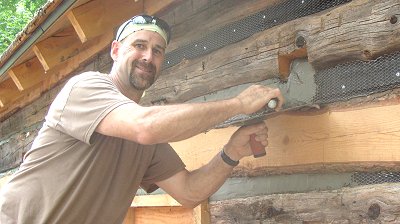
Carl Coté
"In the late 1700s they made full use out of everything that they had," he says. "The hand hewn surface of the log they'd make wood chips, and they'd use that as filler along with anything from twigs and branches to larger branches that would fill the big gaps. It's a little easier using a 2x4 to fill the gaps. The chinking mix is much like what it used to be. They used to use ash and clay soil, a lime mix. They'd also add some salt and vinegar to the mixture. The lime makes it stickier and prevents shrinkage as it dries. The Portland mix is the bonding agent that makes the sand and the other elements adhere."
LaVigne's original idea was to finish the log cabin before Lansing Harbor Festival, at which a dedication ceremony is planned for the cabin. But working a volunteer construction project into the high building season is an exercise in juggling time and resources. The push has been to get as much of the outside completed before the festival as possible. The outside chinking was completed Saturday, and if all goes as planned the front door will be ready. That leaves the side door, windows, and the indoor chinking that will complete the Community Council's plan for the building. Coté says that will be done by Winter. Cabin supporters hope that a new group will form to furnish the interior in period style and provide tours of the cabin.
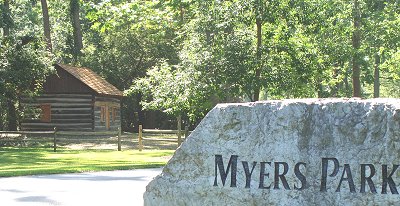
Coté and Cody founded Results Renovation and Repair in May of 2008. The firm works within a 50 mile radius of Groton, doing everything from minor repairs and renovations all the way up to a home addition including excavation, foundation work, and building it from the ground up. Jacques joined the firm about two months ago when he moved here from Florida.
"The cabin has quite a history," Coté says. "It's nice to take the care to bring it back to something that will be here for another hundred and fifty to two hundred years."
----
v6i29



